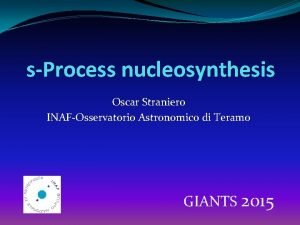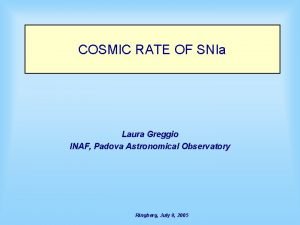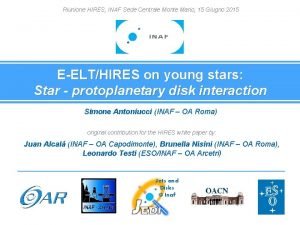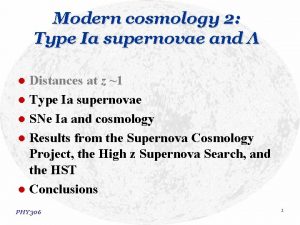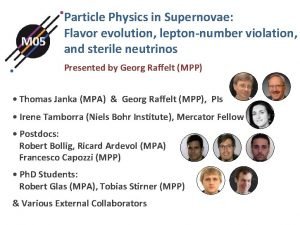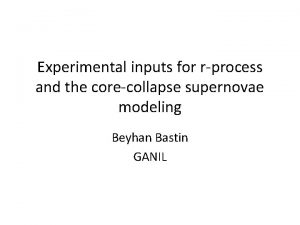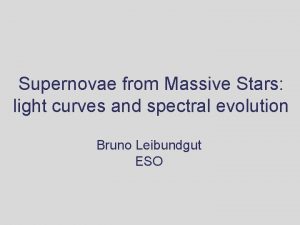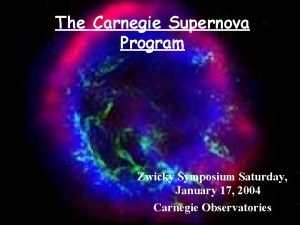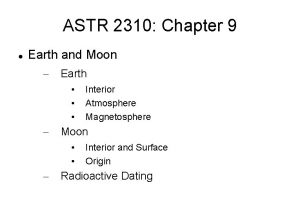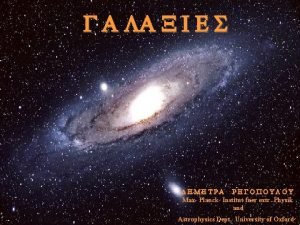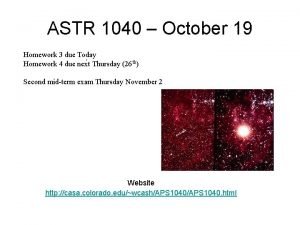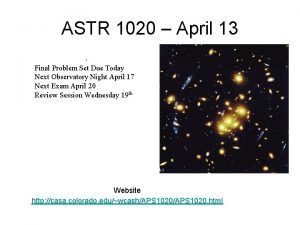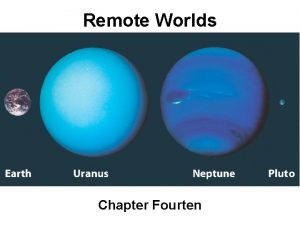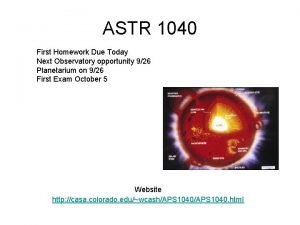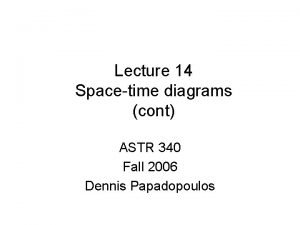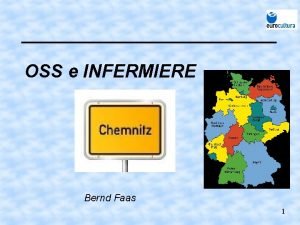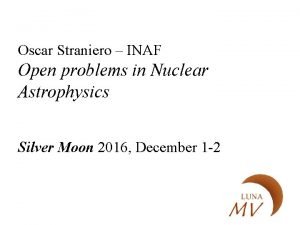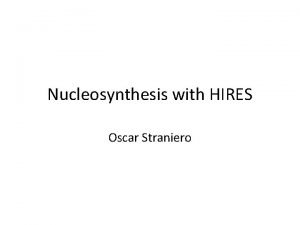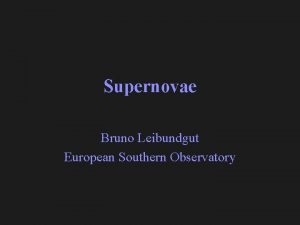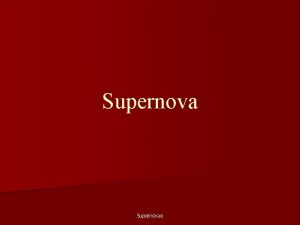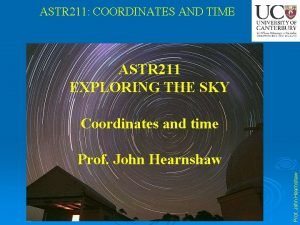Supernovae Oscar Straniero INAF Oss Astr di Collurania



























- Slides: 27

Supernovae Oscar Straniero INAF – Oss. Astr. di Collurania (TE)

SNe Classification II p H Type II II L SNe I b (strong He) Core collapse of massive stars I c (weak He) o N H Type I I a (strong Si) based on spectra and light curve morphology Thermonuclear explosion

Standard Candles Ø Bright Supernovae Ia Ø Homogeneous Ø No evolutionary effects Thermonuclear Explosion of a CO WD M~MChandrasekhar L ~ 1. 4 M Light Curve 56 Ni time 56 Co 56 Fe L MNi

Observed Relations Riess et al. , 1997 Brighter Slower Decline Dimmer Faster Decline

Maximum Brightness - Decline Relation Phillips et al. 1996, 1999 Calibrated locally < > = 0. 17 mag

The conceptually simplest model for a thermonuclear supernova is just an analog of a runaway chemical reaction that become explosive : a conventional bomb. …… bombs often fail. Similarly, most models for astrophysical bombs (Sne Ia) often fail. …… Further, astrophysical bombs must occur naturally and at the correct rate: there must be a convincing astronomical context.

The virial theorem log P Non-degenerate pse a l l co r 4/3 relativistic M 2 M 1 r 5/3 Non-relativistic log r

Massive stars and core collapse Limongi, Straniero & Chieffi, 2001 • e-+p àn+ne (10 Me. V) • 56 Fe+g à 13 a+4 n (124 Me. V)

Evolutionary track of low mass stars PN 0. 6 CO M=1 Mu AGB t=10 Gyr Remnant: CO WD 0. 6 Mu 0. 55 He 0. 2 CO 0. 6 CO HB RGB 0. 1 He WD MS Prada Moroni & Straniero 2002 0. 5 He

Stellar evolution M<0. 8 M¤ t>1/HO 0. 8<M/M¤<8 15 Gyr<t<30 Myr 0. 5<Mf /M¤<1. 1 WD 8<M/M¤<11 t. 10 -30 Myr Mf =1. 2 -1. 3 M¤ WD 11<M/M¤<100 M>100 M¤ t. 1 -10 Myr Mf =1. 2 -2. 5 M¤ (Ye. 0. 45) NS or BH CO ONe. Mg Fe collapse t#1 Myr O (pair jnstability) (Ye=0. 5) may or may not explode

Astrophysical Explosive Devices Thermonuclear SNe C or He detonation C-deflagration C-delayed detonation Gravitational collapse WD WD RG WD Induced Core collapse (nuclear runaway fails) Pair instability, core collapse & O explosion (core collapse fails)

He-detonation Nucleosynthesis in Thermonuclear SNe C-deflagration C-delayed detonation

SNe Ia Light Curves: mass and metallicity effects Domínguez, Hoflich, Straniero 2001

H accreting WDs RG MS Most of the accreted material is lost during the H-pulse: too long time

Merging scenario: Double degenerate systems: CO+CO a) GWR loss b) secondary tidal disruption c) accretion 10 -5 M yr-1 Too fast accretion



Double Degenerate CO WDs (M=8 H 10 -6 M yr-1) (M=10 -8 M yr-1)

Single Degenerate. Massive WDs: the lifting effect of rotation H Dominguez, Straniero, Isern & Tornambe’ 1996 He CO

Double Degenerate Angular momentum deposition & GWR c) accretion 10 -5 M yr-1 (expansion) d c e f g d) “critical” accretion (contraction) ---- disk ---- WD e) tri-axial configuration and energy loss via GWR f) balance between ang. mom. deposition and energy loss (steady accretion) g) Viscous dissipation and explosion Piersanti, Gagliardi, Iben & Tornambe’ 2003

Massive stars g e, e+ n, n

Convective regions

At the onset of the core collapse • e-+p àn+ne (10 Me. V) • 56 Fe+g à 13 a+4 n (124 Me. V)

Pressure contributions

COLLAPSE, BOUNCE & STALL Photo-dissociation & neutronization e-+p àn+ne +0. 2 ms -0. 5 ms +2. 0 ms 1012 g/cm 3 3 x 1014 g/cm 3

Neutrino Energy Deposition & Convection: the way trough a successful explosion neutrino energy =1053 erg kinetic + g energy =1051 erg

SN IIp: Light Curves
 Oscar straniero
Oscar straniero Inaf padova
Inaf padova Xe @150
Xe @150 Supernovae
Supernovae Supernovae
Supernovae Supernovae
Supernovae Supernovae
Supernovae Supernovae
Supernovae Type ia supernovae
Type ia supernovae Chapter
Chapter Astr greek or latin
Astr greek or latin Astr ioi
Astr ioi Astr
Astr Quasar spectrum
Quasar spectrum Trans neptunian objects
Trans neptunian objects Homework due today
Homework due today Astr twins
Astr twins 5-a-day language review week 20 answer key
5-a-day language review week 20 answer key Astr 100 uiuc
Astr 100 uiuc Netflix microservices
Netflix microservices Oss artinya
Oss artinya Corso oss poliambulanza
Corso oss poliambulanza Mansioni oss allegato a e b
Mansioni oss allegato a e b Huawei oss
Huawei oss Clisma fleet oss
Clisma fleet oss Oss
Oss Oss builder osstem
Oss builder osstem Oss or oses
Oss or oses
